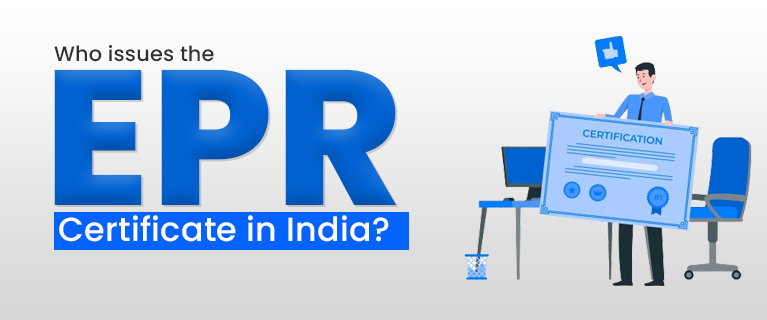Behind The Scenes Of EPR Registration
In a world that's becoming increasingly conscious of environmental concerns and waste management, Extended Producer Responsibility (EPR) is a vital concept. EPR places the onus on manufacturers and importers to manage the environmental impact of their products throughout their life cycle. To comply with this eco-friendly approach, businesses need to go through EPR registration. In this comprehensive guide, we'll take you behind the scenes of EPR registration, demystifying the process, explaining the eligibility criteria, benefits, and the step-by-step procedure to ensure a smoother transition into the world of responsible waste management.
1. What is Extended Producer Responsibility (EPR)?
Extended Producer Responsibility is an environmental policy approach that shifts the burden of waste management from the government and taxpayers to the manufacturers and importers. The concept is simple: if you produce or import a product, you're responsible for managing the waste generated from that product when it reaches the end of its life.
2. The Importance of EPR
EPR is essential because it promotes sustainable production, reduces the environmental impact of products, and encourages manufacturers to adopt eco-friendly practices. By placing responsibility on producers and importers, it drives innovation in product design and encourages recycling and proper disposal.
3. Eligibility for EPR Registration
EPR registration in India is mandatory for manufacturers, importers, and brand owners who produce or import products covered under the E-Waste (Management) Rules, 2016. These products include electronic and electrical equipment, and the eligibility criteria can vary depending on your location and specific products.
4. Benefits of EPR
- Eco-Friendly Reputation: EPR demonstrates your commitment to environmental sustainability, which can enhance your brand's reputation.
- Regulatory Compliance: It ensures you comply with legal requirements and avoid penalties.
- Resource Efficiency: EPR encourages the efficient use of resources and reduces waste.
- Cost Savings: By optimizing product design, you can save on material and disposal costs.
5. The Step-by-Step Guide to EPR Registration
Let's dive into the details of EPR registration and what it entails.
Step 1: Documentation and Preparation
The first step is to gather all necessary documents, including your company's registration certificate, PAN card, GST registration, and details of your products covered under EPR.
Step 2: Choosing the Authorized Representative
Select an authorized representative who will be responsible for ensuring EPR compliance. This individual will liaise with regulatory authorities and implement the EPR plan.
Step 3: EPR Plan Submission
Develop an EPR plan outlining your strategy for waste management and product recycling. Submit this plan to the State Pollution Control Board.
Step 4: Scrutiny and Approval
The authorities will scrutinize your EPR plan. If they find it compliant with their guidelines, they will grant approval.
Step 5: Agreement and Agreement Fee
Once your plan is approved, you'll need to sign an agreement with the State Pollution Control Board. An agreement fee will also apply.
Step 6: EPR Plan Implementation
Implement your EPR plan, which may include setting up collection centres, recycling facilities, and awareness programs.
Step 7: Complying with Reporting Requirements
You'll need to comply with periodic reporting requirements, including information about waste collection, disposal, recycling, and more.
Step 8: Annual Reporting and Compliance Fee
Annually, submit a compliance report along with a compliance fee as required by the State Pollution Control Board.
Read Also This - Mastering The GST Refund Process
Expert Tips for EPR Registration Success
Successfully navigating the EPR registration process involves careful planning and adherence to guidelines. Here are some expert tips to ensure your EPR registration goes smoothly:
a. Seek Professional Guidance: EPR regulations can be complex and vary across regions. Consider hiring a consultant or legal expert like LegalRaasta. With experience in EPR of more than 10 years, we can guide you through the entire process.We can also help you understand specific state-level requirements and streamline your registration.
b. Conduct a Waste Audit: Before submitting your EPR plan, conduct a thorough waste audit to understand the types and quantities of waste your products generate. This audit forms the basis for your EPR plan and helps you set realistic targets for waste reduction and recycling.
c. Collaborate with E-Waste Recyclers: Building partnerships with certified e-waste recycling companies can be beneficial. Your EPR plan should include strategies for channelizing e-waste to these recyclers. Collaborative efforts with these recyclers can lead to more effective and eco-friendly waste management.
d. Create Consumer Awareness Programs: Part of EPR is educating consumers on responsible disposal of electronic products. Implementing awareness campaigns not only fulfills your EPR obligations but also helps reduce the environmental impact of improper disposal.
EPR and Global Environmental Initiatives:
Environmental concerns extend beyond national borders. Hence, it's crucial to view EPR not in isolation but as part of a broader global initiative to address environmental challenges. One of the most prominent global initiatives is the Paris Agreement, which seeks to combat climate change and promote environmental sustainability.
The Paris Agreement, adopted in 2015, represents a collective effort by nations worldwide to limit global warming to well below 2 degrees Celsius above pre-industrial levels. The agreement acknowledges the significant role of the private sector and industries in achieving its objectives. EPR plays a vital part in this effort. By mandating that producers take responsibility for the entire life cycle of their products, EPR aligns with the principles of reducing greenhouse gas emissions and promoting sustainable resource use. This connection highlights the significance of EPR as an instrument that resonates with international goals, emphasizing how it's not just a national but a global imperative.
EPR's Role in Circular Economy:
The circular economy is a regenerative economic model designed to minimize waste and make the most of resources. It envisions a world where products, materials, and resources remain in use for as long as possible, thereby reducing the need for constant production and minimizing the environmental impact.
EPR plays a pivotal role in realizing the vision of a circular economy. By making manufacturers responsible for the products they bring into the market from inception to disposal, EPR encourages product design that is geared towards reusability, recyclability, and longer product life cycles. It reinforces the concept of 'closing the loop' by ensuring that products are collected, recycled, and reintroduced into the production cycle. In doing so, EPR aligns with the principles of a circular economy and acts as a significant driver in achieving sustainability goals.
Challenges in Implementing EPR:
While EPR offers a multitude of environmental and social benefits, its implementation can be fraught with challenges. Several common hurdles need to be addressed:
1. Initial Investment: Businesses may face significant upfront costs for developing the infrastructure required for effective waste management and recycling. While this investment is usually cost-effective in the long run, it can pose a barrier for some.
2. Complex Regulations: Navigating the regulatory framework of EPR, which varies from one jurisdiction to another, can be a daunting task. Ensuring full compliance while dealing with complex laws can be a challenge for both businesses and regulatory bodies.
3. Consumer Participation: The success of EPR programs hinges on active consumer participation in recycling efforts. Creating awareness and changing consumer behavior can be a challenging task. Incentives and awareness campaigns are often necessary to encourage consumers to participate.
4. E-Waste Handling: Handling electronic waste, in particular, presents unique challenges due to the presence of hazardous materials. Ensuring the safe disposal and recycling of e-waste requires specialized facilities and expertise.
5. Monitoring and Reporting: EPR schemes require accurate data collection and reporting. Establishing robust systems for tracking waste collection, recycling, and reporting can be complex without the right technology.
In essence, while EPR offers significant benefits, acknowledging and addressing these challenges is essential to ensure a smooth and effective implementation.
Read Also This - How To Get EPR Certificate For Your E waste Management
The Role of Technology in EPR Compliance:
In an era dominated by technology, leveraging digital solutions and software plays a crucial role in making EPR compliance more efficient and effective. Here's how technology aids in ensuring EPR compliance:
1. Tracking and Reporting: Software solutions can streamline the tracking and reporting of products throughout their lifecycle. This helps in gathering accurate data on waste generation, collection, and recycling.
2. Data Management: Technology enables efficient data management, ensuring that all stakeholders have access to the necessary information in real-time. This promotes transparency and accountability in EPR programs.
3. Consumer Engagement: Mobile apps and digital platforms can be used to engage consumers actively. These tools can provide information on recycling centers, schedule pickups, and even offer incentives for participating in EPR programs.
4. Auditing and Verification: Technology can simplify the auditing and verification process, making it easier for regulatory bodies to ensure compliance. Digital records are often easier to access and audit than paper-based documentation.
5. Innovation: Technology encourages innovation in recycling processes. Advanced sorting and recycling technologies are constantly evolving, making recycling more efficient and environmentally friendly.
Incorporating technology into EPR compliance not only enhances data accuracy and reporting but also encourages wider participation. It simplifies the entire process, from waste collection to recycling, making EPR a more efficient and sustainable approach for managing the environmental impact of products.
In conclusion, EPR registration is a multifaceted journey that involves not only fulfilling legal requirements but also contributing to a sustainable and eco-friendly future. By understanding the complete process, recognizing its broader environmental significance, learning from challenges, and drawing inspiration from successful case studies, businesses can approach EPR registration with confidence and vision.
As we move forward into an era where environmental responsibility is paramount, EPR remains at the forefront of the battle to protect our planet. Embracing this responsibility is not just a choice; it's a commitment to a healthier, cleaner, and more sustainable world for current and future generations. EPR may seem like a process behind the scenes, but its impact is front and center in the global effort to safeguard our environment.










